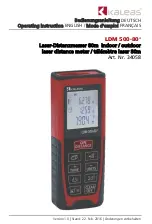
Section 6. Data Table Declarations and Output Processing Instructions
6-6
WorstCase (TableName, NumCases, MaxMin, Change, RankVar)
Allows saving the most significant or “worst-case” events in separate data
tables.
A data table is created that is sized to hold one event. This table acts as the
event buffer. Each event that occurs is stored to this table. This table may use
the DataEvent instruction or some other condition to determine when an event
is stored. The significance of an event is determined by an algorithm in the
program and a numerical ranking if the event is stored in a variable.
WorstCase creates as many clones of the specified table as the number of cases
for which to keep data. When WorstCase is executed, it checks the ranking
variable; if the value of the variable is a new worst case, the data in the event
table replace the data in the cloned table that holds the least significant event
currently stored.
An additional data table,
name
WC (e.g., EvntWC) is created that holds the
values of the rank variables for each of the worst case tables and the time that
that table was stored.
WorstCase must be used with data tables sent to the CPU. It will not work if
the event table is sent to the PAM module or CPU Flash memory.
While WorstCase acts as Trigger Modifier and a data table declaration
(creating the cloned data tables), it is entered within the program to call the
worst case tables (see example).
Parameter
& Data Type
Enter
WorstCase Parameters
TableName
name
The name of the data table to clone. The length of this name should be 4 characters or less so the
complete names of the worst case tables are retained when collected (see NumCases).
NumCases
The number of “worst” cases to store. This is the number of clones of the data table to create. The
cloned tables use the name of the table being cloned (up to the first 6 characters) plus a 2 digit number
(e.g., Evnt01, Evnt02, Evnt03, …). The numbers give the tables unique names, they have no
relationship to the ranking of the events. PC9000 uses this same name modification when creating a new
data file for a table. To avoid confusion and ambiguous names when collecting data with PC9000, keep
the base name four characters or less (4character base name + 2 digit case iden 2 digit collection
identifier = 8 character maximum length).
MaxMin
A code specifying whether the maximum or minimum events should be saved.
Constant
Value Result
0
Min
, save the events associated with the minimum ranking; i.e., Keep
track of the RankVar associated with each event stored. If a new
RankVar is less than previous maximum, copy the event over the event
with previous maximum)
1
Max
, save the events associated with the maximum ranking; i.e., copy
if RankVar is greater than previous lowest (over event with previous
minimum)
Change
Constant
The minimum change that must occur in the RankVariable before a new worst case is stored.
RankVar
Variable
The Variable to rank the events by.
Summary of Contents for CR9000
Page 6: ...CR9000 Table of Contents iv This is a blank page ...
Page 22: ...CR9000 Overview OV 16 This is a blank page ...
Page 26: ...Section 1 Installation 1 4 CR9000 FIGURE 1 1 3 CR9000 Battery Pack ...
Page 72: ...Section 3 CR9000 Measurement Details 3 28 This is a blank page ...
Page 88: ...Section 5 Program Declarations 5 6 This is a blank page ...
Page 217: ...This is a blank page ...
















































